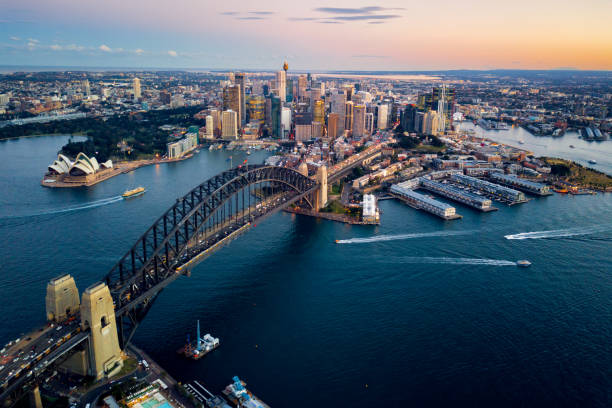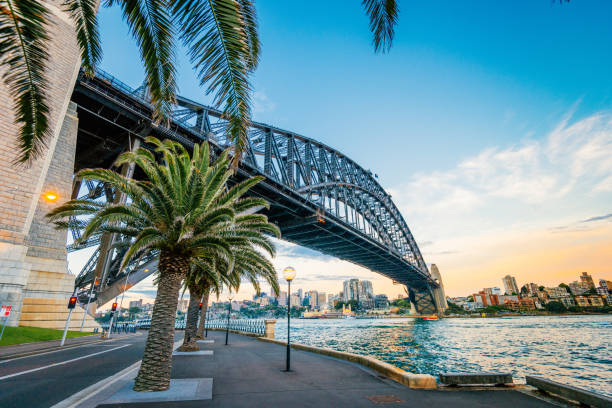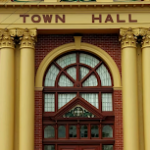The Sydney Harbour Bridge is not only an iconic structure defining the skyline of Sydney, Australia, but also an engineering marvel with rich historical significance. Spanning the Sydney Harbour, it connects the Sydney central business district with the North Shore, offering both functional transportation benefits and a tourist attraction. Known locally as “The Coat Hanger” due to its arch-based design, the bridge’s construction was a monumental task, intertwining with Australia’s economic, cultural, and historical fabric. In this article, we delve into the compelling facts and history of this grand edifice.
The Idea and Construction

The concept of building a bridge across the Sydney Harbour was first conceived as early as the 1800s, but it was not until 1923 that construction officially began. Dr. J.J.C. Bradfield, the Chief Engineer of Sydney Harbour Bridge and Metropolitan Railway Construction, was the visionary behind the bridge’s design. Bradfield and his team envisioned a bridge that would not only solve the city’s traffic issues but also become a symbol of national pride. The government finally awarded the construction contract to the British firm Dorman Long and Co Ltd of Middlesbrough.
The construction phase embodied the zenith of teamwork and diligence, involving around 1,400 workers, and it took eight years to complete. The towering twin piers, made from granite hauled from the town of Moruya, were the pillars upon which the 39,000 tons of steel for the arch were set. On 19th March 1932, after the massive endeavor, the bridge was finally opened to the public. It was a momentous event attended by vast crowds and celebrated for both its aesthetic grace and the engineering prowess it represented.
Design and Dimensions
The Sydney Harbour Bridge’s design is as striking as it is sturdy. It was engineered as a through arch bridge, with its distinctive arch rising 134 meters above the harbour. It measures 503 meters in length, making it one of the longest steel-arch bridges in the world. The bridge’s width takes the record for the widest long-span bridge at 49 meters, holding eight lanes for road traffic, two railway tracks, a pedestrian walkway, and a cycle path.
The arch itself is composed of two hinged spandrel-braced arches, acting in unison to support the bridge’s deck. Each end of the arch features hangers that are connected to the deck, effectively distributing the structural load. The design ensures that no matter how heavy the traffic, the bridge can comfortably support the weight. Its ability to withstand both human-made and natural pressures has earned it recognition as a feat of modern engineering.
The Opening Ceremony and Its Legacy
The grand opening ceremony of the Sydney Harbour Bridge was as dramatic as its construction process. On the day of its inauguration, Francis de Groot, a member of the political group the New Guard, slashed the ribbon with a sword before the official ceremony could take place, declaring the bridge open in the name of “the decent and respectable people of New South Wales.” This outburst was a controversial moment in the otherwise festive and patriotic celebrations. Nevertheless, the official ribbon was retied, and the ceremony continued, presided over by the NSW Premier, Jack Lang.
Since the opening, the bridge has become a central part of Sydney’s ethos. It has provided an essential link for both commuters and tourists, and its aesthetic appeal has made it one of the most photographed landmarks in the city. Moreover, the bridge has become an integral part of major events, such as the Sydney New Year’s Eve fireworks display, a symbol of unity and festivity for Australians.
BridgeClimb and Tourism
In 1998, the bridge took on another role that further cemented its status as a global attraction – BridgeClimb was launched, allowing adventurous souls to scale the arches and experience breathtaking views from the summit. Equipped with safety harnesses and led by professional guides, climbers encounter a unique perspective of Sydney, which has wooed over four million participants from around the world.
The climb has various options, including dawn, day, twilight, or night climbs, each offering a different hue of the Sydney skyline and harbour waters. This immersive experience not only provides an adrenaline rush but also offers an educational journey through the history of the bridge, as guides share anecdotes and facts about the construction and maintenance of this colossal structure.
Interesting Facts and Figures
- It took 53,000 tonnes of steel and 6 million hand-driven rivets to construct the bridge.
- The total cost of the bridge was approximately 6.25 million Australian pounds, and it wasn’t paid off until 1988.
- The paint surface area of the Sydney Harbour Bridge covers an equivalent of around 60 sports fields and requires regular maintenance.
- The bridge’s pylons are primarily ornamental and made of concrete covered with granite.
- Danny Deckchair, a feature film released in 2003, was inspired by an incident where a man tied weather balloons to a lawn chair – mimicking a flight over the Harbour Bridge.
Conclusion
The Sydney Harbour Bridge stands as a testament to human ingenuity and perseverance. It signifies Australia’s advancement during the early 20th century and remains an iconic structure recognized world over. The bridge is not only a vital transport link but also a symbol of the vibrant character and history of Sydney, interweaving utility with splendor. Its ongoing legacy as a tourist attraction, coupled with its storied past, continues to capture the hearts and imaginations of locals and visitors alike.
FAQs About Sydney Harbour Bridge
1. When was the Sydney Harbour Bridge officially opened?
The Sydney Harbour Bridge was officially opened on March 19, 1932.
2. Can you walk across the Sydney Harbour Bridge?
Yes, pedestrians can walk across the bridge via the pedestrian walkway.
3. How much steel was used in the construction of the Sydney Harbour Bridge?
Approximately 53,000 tonnes of steel were used to construct the bridge.
4. Is it possible to climb the Sydney Harbour Bridge?
Yes, visitors can climb the bridge through a guided experience known as BridgeClimb.
5. Does the Sydney Harbour Bridge still require regular maintenance?
Yes, the bridge requires consistent maintenance, including painting and structural checks, to ensure its durability and safety.


